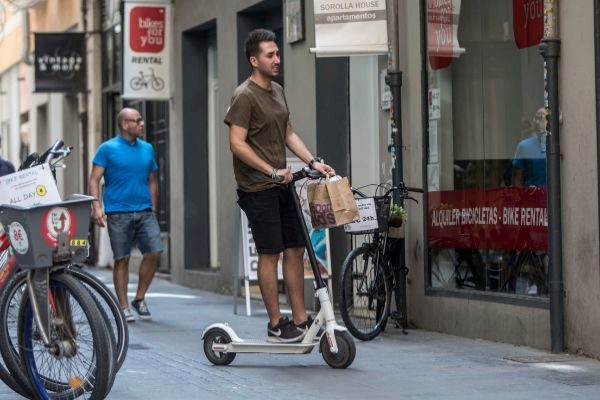- Interview: "Fighting pollution is not a matter of polar bears, but of lungs and heart"
- Road safety Electric scooter courses to prevent accidents and accidents
The former appeared as an exotic and futuristic novelty, but in just a couple of years they have become part of the landscape of large cities, almost as an invasive species. Paradigm of micromobility, electric scooters respond to users' desire to move faster and faster and become more ecological. This is why rental companies emphasize presenting them as a sustainable alternative and free of CO2 emissions, although a new study published in the Environmental Research Letters magazine reveals that reality is much more complex.
To measure its true environmental impact, a team of researchers from the University of North Carolina has analyzed the emissions generated throughout its existence: the production of materials and components, transportation from the factory and collection, loading and redistribution in the cities. Then they have compared their ecological footprint with that of the other transport options based on four factors: their impact on climate change, on the nutrient load in the water, on air pollution and on the acidification it causes in ecosystems .
The result is that current shared electric scooter systems may be less ecological than bicycles or public transport, especially on the lines that move more passengers. Of course, they are always a preferable alternative to the car. "Its environmental impact comes mostly from two areas: the use of other vehicles to collect and distribute scooters and emissions related to the production of materials and components," explains researcher Jeremiah Johnson, co-author of the article.
Replace the car
Road traffic generates 25% of total greenhouse gas emissions, associated with climate change and between 30 and 35% of suspended particles (PM), linked to respiratory diseases. In this context, with increasingly populated cities, personal mobility vehicles (VMP) such as electric scooters are sold as alternatives to reduce car use and the pollution it produces.
The problem is that rental companies turn to companies and users to collect, load and redistribute the scooters in the places they consider most appropriate, an activity that is largely carried out with cars. "The result is that in cities like Madrid you have a fleet of vans circulating and competing with each other every night," says Paco Segura, coordinator of Ecologists in Action.
The study also points to another problem: only one third of the electric scooter trips are replacing car trips. Most users would have made the journey by bicycle, on foot or by public transport. Data similar to those published in previous surveys both in Europe and in other US cities. This summer Estonia has launched the largest free public transport system in the world, but in Tallinn researchers have found that the plan is not reducing car travel, but walking journeys. "The key is what displacements are replaced," says Segura, "if it is done on an electric scooter instead of walking or cycling, the trip has a higher environmental cost. This study shows that electric scooters are a complement, but the problems are not the solution. "
Legislation
On the other hand, there is the constant replacement required by theft and vandalism . A high percentage of the fleets has to be replaced regularly and the manufacture of these scooters and their engines has a cost in the mining and metallurgical industry, especially for the aluminum they require. In addition, most models used by rental companies in Europe and the US come from China, which adds long-distance transport. "If companies were able to extend the life of their scooters without increasing the impact of their manufacturing, that would reduce their carbon load per kilometer," says Johnson. "If it were to last two years, it would have a great positive impact."
As with any other novelty, public regulation tries to catch up with reality. In Marseille, the city council has just regulated its use, given the flood of electric scooters that are being thrown into the Mediterranean, creating an added environmental problem. In Spain, Traffic works on a normative basis for this year, which will prohibit them from traveling on sidewalks or going over 25 km / h. The municipalities, meanwhile, try to adapt and find the balance between a vehicle that could decongest traffic and a problem of coexistence in the public space. "If there were more anchors that could be loaded, such as those of municipal bicycle services, it would be a positive change," says Segura, "in addition to preventing them from being left lying on the sidewalks."
For its part, one of the main operators in the sector, Lime, has responded to the study in a statement, thanking "the research on the environmental benefits of the new mobility options" but criticizing "that the work is based largely on assumptions and incomplete data that produce great variability in results. We believe that micromobility will reduce pollution and mitigate climate change through clean and efficient means of transport and we are moving forward with technology and activities that help us to be a more sustainable company. "
According to the criteria of The Trust Project
Know more- Science and Health
- science
Science and Health The danger of moisturizers for breast milk
ExpeditionThe 'ecoheroine' odyssey Greta Thunberg: will cross the Atlantic on a sailboat
SCIENCE An astronaut plays dj from space for a cruise in Ibiza

